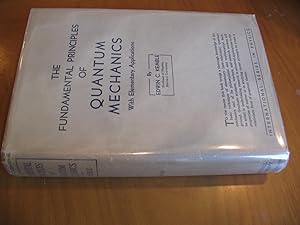About this Item
Xiii, 611 Pp. Olive Cloth, Gilt. First Edition Stated. Near Fine Book With Touch Of Rubbing At Corners, Ownership Name On Front Endpaper. Dj Lightly Used, A Few Short Tears, 1/2" Squarish Chip At Upper Left Corner Of Rear Panel, Small To Minute Losses At Corners. Edwin Crawford Kemble (1889?1984) Was An American Physicist Who Made Contributions To The Theory Of Quantum Mechanics And Molecular Structure And Spectroscopy. He Received His Ph.D. In Physics From Harvard In 1917.After Kemble Received His Doctorate, With World War I In Progress, He Spent A Short Time Doing Work Which Contributed To The War Effort Developing Aircraft Engines At Curtiss Aeroplane And Motor Company. As The War Ended, He Was Laid Off. While He Did Want To Return To Harvard, A Position Could Not Immediately Be Found, So He Spent A Half Semester Teaching At Williams College, In Williamstown, Massachusetts. Bridgman Had A Plan To Build Up Theory At Harvard, Which Consisted Of Restructuring From The Emphasis In Electromagnetism (Radiotelegraphy, Optics, And Wave Propagation) To Radiation Theory, Quantum Theory, Photo-Electricity, Specific Heats, X-Ray Crystal Structure, And Special Topics In Physics Theory. Kemble Accepted The Challenge And Returned To Harvard In 1919 As An Assistant Professor In The Physics Department. Kemble Remained There The Rest Of His Career As Instructor (1919?1924), Assistant Professor (1924?1927), Associate Professor (1927?1930), And Professor (1930?1957).[6] He Was Made Chairman Of The Department In 1940. His First Graduate Student Was John Van Vleck. Many Other Doctoral Students And Postdoctoral Students/Researchers Followed In The Next Fifteen Years, Including Robert S. Mulliken,[ John C. Slater, J. Robert Oppenheimer, Clarence Zener, James H. Bartlett, Eugene Feenberg, And J. L. Dunham. Kemble Was At The Center Of Research And Development Of The Theory Of Molecular Structure. Kemble Went To Study And Do Research With Both Sommerfeld In Munich And Born In Göttingen, On A Guggenheim Fellowship In 1927-1928. Upon His Return To The United States, He Wrote, With Edward L. Hill, Two Lengthy Reviews Of Quantum Mechanics In The First Issues Of Reviews Of Modern Physics. During World War Ii, Kemble Supervised The Teaching Of Basic Physics To Military Officers, Consulted With For The Navy On Acoustic Detection Of Submarines, And Near The End Of The War Consulted For The Army On Operation Alsos. The Objective Of Alsos Was To Investigate The German Nuclear Energy Efforts, Seize German Nuclear Resources, Materials And Personnel To Further American Research And To Prevent Their Capture By The Soviets, And To Discern How Far The Germans Had Gone Towards Creating An Atomic Bomb. Samuel Goudsmit, A Quantum Physicist From The University Of Michigan, Was The Scientific Leader Of Alsos, And Lt. Col. Boris Pash, A Former Manhattan Project Security Officer, Was Its Military Leader. At The End Of Ww Ii, Kemble Had The Opportunity To Continue His War-Time Interest In Teaching Physics To Non-Physicists. In Reacting To The Role Science Played In The War, James B. Conant, President Of Harvard And Former High-Level Administrator In The Manhattan Project, Proposed Teaching Science To All Harvard Undergraduates By Teaching Them The History Of Science And Highlighting The Importance Of Science To Social Change. Kemble Joined I. Bernard Cohen, Gerald Holton, Thomas S. Kuhn, Philippe Le Corbeiller, And Leonard K. Nash In This Project. In 1957, Kemble Retired From Harvard, Where He Had Spent All But Three Years Since He Entered Graduate School. For The Next Three Years, He Was The Director Of Harvard's Academic Year Institute, Where High-School Teachers Studied With University Professors. He Had Served As Chairman Of The Physics Section Of The National Academy Of Sciences (1945?1948) And As A Member Of The Executive Committee Of The National Research Councils? Division Of Physical Sciences.[. Seller Inventory # 033140
Contact seller
Report this item
![]()
